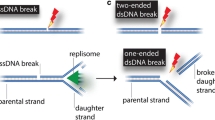Abstract
ST1 is an artificial mini-chromosome approximately 4.5 Mb in size containing mouse minor and major satellite DNA, human alphoid DNA and sequences derived from interval 5 of the human Y chromosome. Here we have measured the mitotic and meiotic transmission of ST1 and have used the mini-chromosome to define the ability of mice to monitor the presence of unpaired centromeres during meiosis. ST1 is mitotically stable, remaining intact and autonomous in mice for many generations. Female mice efficiently transmit ST1 to their offspring at a frequency approaching 50%. Male mice also reliably transmit the mini-chromosome, though to only 20% of their offspring. Presence of ST1 in males is not associated with any compromise in the output of the seminiferous epithelium nor with histological or immunocytochemical evidence of increased apoptosis, outcomes predicted for a synapsis checkpoint. These data indicate that the presence of an unpaired centromere is not sufficient to arrest male meiosis, implying that univalents are normally eliminated by a mechanism other than a tension-sensitive spindle checkpoint.


Similar content being viewed by others
References
Eaker S, Pyle A, Cobb J, Handel MA (2001) Evidence for meiotic spindle checkpoint from analysis of spermatocytes from Robertsonian-chromosome heterozygous mice. J Cell Sci 114:2953–2965
Hassold T, Abruzzo M, Adkins K, Griffin D, Merrill M, Millie E, Saker D, Shen J, Zaragoza M (1996) Human aneuploidy: incidence, origin, and etiology. Environ Mol Mutagen 28:167–175
Hunt P, LeMaire R, Embury P, Sheean L, Mroz K (1995) Analysis of chromosome behavior in intact mammalian oocytes: monitoring the segregation of a univalent chromosome during female meiosis. Hum Mol Genet 4:2007–2012
Jacobs HCAP (1957) The meiotic process in Mantis religiosa L males. J Genet 55:200–217
Kazuki Y, Shinohara T, Tomizuka K, Katoh M, Ohguma A, Ishida I, Oshimura M (2001) Germline transmission of a transferred human chromosome 21 fragment in transchromosomal mice. J Hum Genet 46:600–603
Koehler KE, Hawley RS, Sherman S, Hassold T (1996) Recombination and nondisjunction in humans and flies. Hum Mol Genet 5:1495–1504
Koehler KE, Millie EA, Cherry JP, Burgoyne PS, Evans EP, Hunt PA, Hassbold TJ (2002) Sex-specific differences in meiotic chromosome segregation revealed by dicentric bridge resolution in mice. Genetics 162:1367–1379
Kuroiwa Y, Tomizuka K, Shinohara T, Kazuki Y, Yoshida H, Ohguma A, Yamamoto T, Tanaka S, Oshimura M, Ishida I (2000) Manipulation of human minichromosomes to carry greater than megabase-sized chromosome inserts. Nat Biotechnol 18:1086–1090
LeMaire-Adkins R, Hunt PA (2000) Nonrandom segregation of the mouse univalent X chromosome: evidence of spindle-mediated meiotic drive. Genetics 156:775–783
Li R, Murray AW (1991) Feedback control of mitosis in budding yeast. Cell 66:519–531
Li X, Nicklas RB (1995) Mitotic forces control a cell-cycle checkpoint. Nature 373:630–632
Mahadevaiah SK, Lovell-Badge R, Burgoyne PS (1993) Tdy-negative XY, XXY and XYY female mice: breeding data and synaptonemal complex analysis. J Reprod Fertil 97:151–160
Nicklas RB, Waters JC, Salmon ED, Ward SC (2001) Checkpoint signals in grasshopper meiosis are sensitive to microtubule attachment, but tension is still essential. J Cell Sci 114:4173–4183
Odorisio T, Rodriguez TA, Evans EP, Clarke AR, Burgoyne PS (1998) The meiotic checkpoint monitoring synapsis eliminates spermatocytes via p53-independent apoptosis. Nat Genet 18:257–261
Print CG, Loveland KL (2000) Germ cell suicide: new insights into apoptosis. Bioessays 22:423–430
Shen MH, Yang J, Loupart ML, Smith A, Brown W (1997) Human mini-chromosomes in mouse embryonal stem cells. Hum Mol Genet 6:1375–1382
Shen MH, Mee PJ, Nichols J, Yang J, Brook F, Gardner RL, Smith AG, Brown WRA (2000) A structurally defined mini-chromosome vector for the mouse germ line. Curr Biol 10:31–34
Shonn MA, McCarroll R, Murray AW (2000) Requirement of the spindle checkpoint for proper chromosome segregation in budding yeast meiosis. Science 289:300–303
Stern BM, Murray AW (2001) Lack of tension at kinetochores activates the spindle checkpoint in budding yeast. Curr Biol 11:1462–1467
Tanaka TU, Rachidi N, Janke C, Pereira G, Galova M, Schiebel E, Stark MJ, Nasmyth K (2002) Evidence that the Ipl1-Sli15 (Aurora kinase-INCENP) complex promotes chromosome bi-orientation by altering kinetochore-spindle pole connections. Cell 108:317–329
Taylor SS, Hussein D, Wang Y, Elderkin S, Morrow CJ (2001) Kinetochore localisation and phosphorylation of the mitotic checkpoint components Bub1 and BubR1 are differentially regulated by spindle events in human cells. J Cell Sci 114:4385–4395
Tomizuka K, Yoshida H, Uejima H, Kugoh H, Sato K, Ohguma A, Hayasaka M, Hanaoka K, Oshimura M, Ishida I (1997) Functional expression and germline transmission of a human chromosome fragment in chimaeric mice. Nat Genet 16:133–143
Tomizuka K, Shinohara T, Yoshida H, Uejima H, Ohguma A, Tanaka S, Sato K, Oshimura M, Ishida I (2000) Double trans-chromosomic mice: maintenance of two individual human chromosome fragments containing Ig heavy and kappa loci and expression of fully human antibodies. Proc Natl Acad Sci USA 97:722–727
Voet T, Vermeesch J, Carens A, Durr J, Labaere C, Duhamel H, David G, Marynen P (2001) Efficient male and female germline transmission of a human chromosomal vector in mice. Genome Res 11:124–136
Vollrath D, Foote S, Hilton A, Brown LG, Beerromero P, Bogan JS, and Page DC (1992) The human Y-chromosome - a 43-interval map based on naturally-occurring deletions. Science 258:52–59
Acknowledgements
We thank Andrew Ross for FISH/immunocytochemistry analysis, Carol Manson and staff for excellent mouse husbandry; and Joanne Povey and Frances Stenhouse for PCR analysis. This project was funded by the Medical Research Council, UK.
Author information
Authors and Affiliations
Corresponding author
Additional information
Communicated by T. Hassold
P.J. Mee and M.M. Shen contributed equally to this article
Rights and permissions
About this article
Cite this article
Mee, P.J., Shen, M.H., Smith, A.G. et al. An unpaired mouse centromere passes consistently through male meiosis and does not significantly compromise spermatogenesis. Chromosoma 112, 183–189 (2003). https://doi.org/10.1007/s00412-003-0260-6
Received:
Accepted:
Published:
Issue Date:
DOI: https://doi.org/10.1007/s00412-003-0260-6




